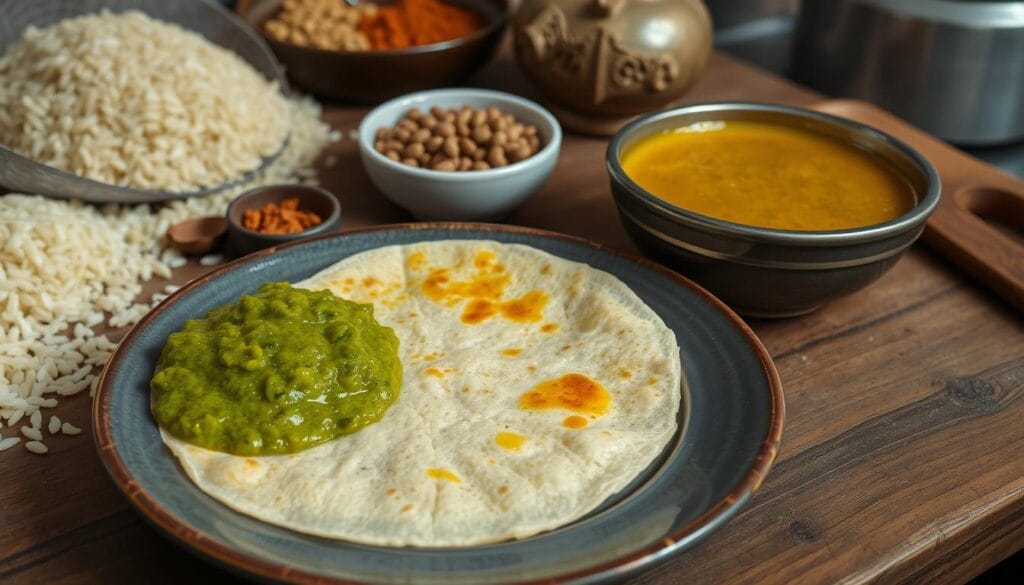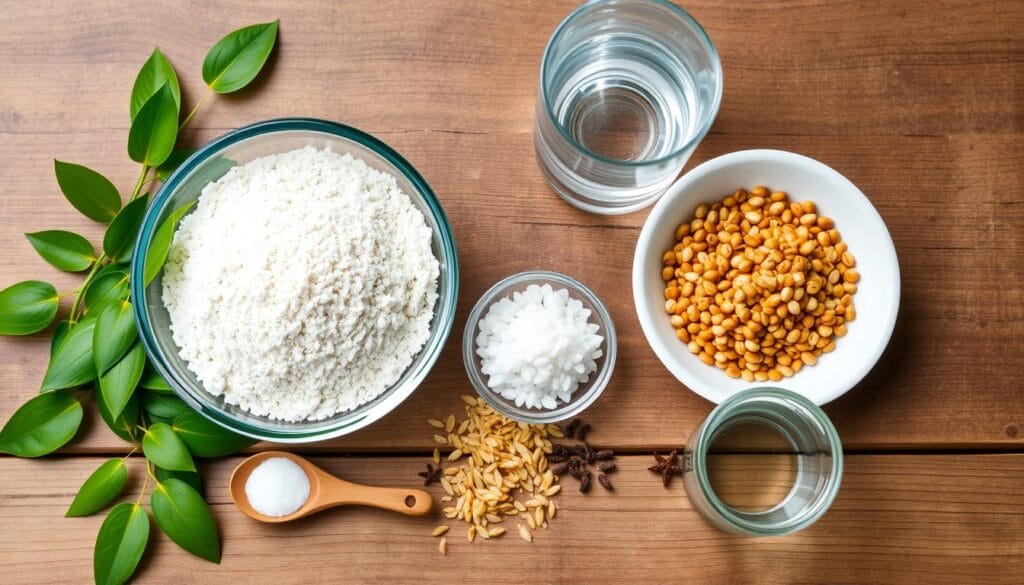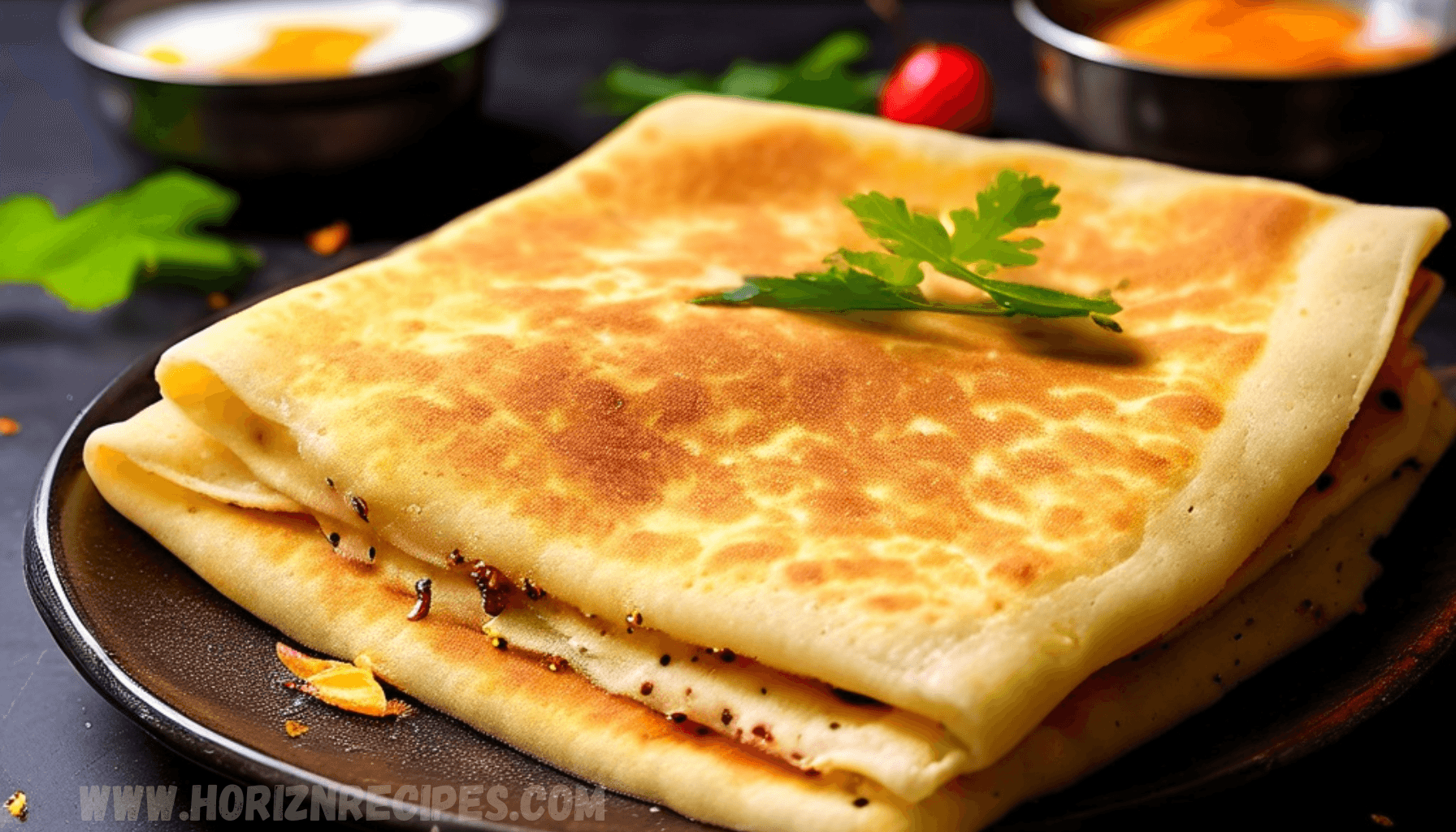Dosas are a favorite in South India, making mornings or evening snacks special. This guide will show you how to make soft and spongy dosas at home. You’ll get tips from chefs to get the perfect dosa texture, whether it’s for breakfast or a snack.

Key Takeaways
- Learn the perfect technique to make soft and spongy dosas at home
- Discover the importance of fermentation for achieving the ideal dosa texture
- Explore a step-by-step recipe for creating the best dosa batter
- Understand common dosa batter issues and how to troubleshoot them
- Enjoy dosas as a versatile instant breakfast or evening snack option
What is a Soft and Spongy Dosa?
A soft and spongy dosa is a favorite in South India. It’s known for its light, airy texture. Over time, it has become a key breakfast and snack item in the country.
The best dosa is thin, crispy on the edges, and soft in the middle. It should feel like it melts in your mouth.
Defining the Perfect Dosa Texture
The perfect dosa has a mix of crispiness and softness. The outside should be thin and crispy. The inside should be light, fluffy, and almost like a sponge.
This special texture comes from a careful fermentation process. It turns the fermented dosa batter recipe into a tasty treat.
Exploring the Origins of the Dosa
The dosa’s roots are in southern India. The traditional dosa making process has been honed over generations. Initially, dosas were a simple, healthy meal of rice and lentils.
But they have grown into a diverse and loved dish across the Indian subcontinent.
“A good dosa is a delicate balance of crispness and softness, with a flavor that is both comforting and complex.”
Dosas are enjoyed at any time of day. They are a beloved part of South Indian cuisine. They show the region’s rich culinary history.

Ingredients for the Best Dosa Batter
The secret to making soft and spongy indian breakfast dosa is in the right mix of ingredients. The traditional best dosa recipe for beginners uses rice and urad dal. Together, they create the perfect texture and taste.
To make the perfect indian breakfast dosa batter, you’ll need:
- Long-grain rice (such as basmati)
- Urad dal (split black lentils)
- Fenugreek seeds (optional, for added flavor)
- Salt to taste
- Water
The ratio of rice to urad dal is key. A common mix is 3 parts rice to 1 part urad dal. But, you can tweak it to your liking and the dosa type you prefer.
| Ingredient | Quantity |
|---|---|
| Long-grain rice | 3 cups |
| Urad dal | 1 cup |
| Fenugreek seeds (optional) | 1 teaspoon |
| Salt | 1 teaspoon |
| Water | Enough to soak the grains |
By choosing and mixing these ingredients carefully, you can make a best dosa recipe for beginners. This will give you soft, spongy, and tasty indian breakfast dosa.

Traditional Dosa Batter Fermentation Process
Fermentation is key in making traditional dosa. It brings out the batter’s unique taste and light texture. The natural yeasts and bacteria in the batter break down starch and proteins. This makes the dosas soft and spongy.
Importance of Fermentation for Soft and Spongy Dosas
Getting the dosa texture right is all about fermentation. As the batter ferments, yeasts and bacteria release carbon dioxide. This makes the dosa light and fluffy. The fermentation also deepens the flavor of the fermented dosa batter recipe.
Tips for Successful Fermentation
- Maintain the right temperature: The optimal fermentation temperature range is between 75°F to 85°F (24°C to 29°C).
- Monitor the fermentation duration: Depending on the climate, the batter may require 8 to 12 hours of fermentation to reach the desired consistency.
- Ensure a well-hydrated batter: The batter should have the right balance of water content to allow for efficient gas exchange during fermentation.
- Incorporate a starter culture: Adding a small amount of previously fermented batter can kickstart the fermentation process and ensure consistent results.
By following these traditional dosa making process tips, home cooks can unlock the secrets to creating soft, spongy, and flavorful dosas every time.
Soft and Spongy Dosa Recipe
Step-by-Step Instructions
Making soft and spongy dosas at home is simple. Just follow these easy steps to make delicious dosas that will excite your taste buds.
Start by soaking equal parts of rice and urad dal (black lentils) for 4 to 8 hours. Drain them and put them in a blender. Add a pinch of salt and enough water to make a smooth batter.
Let the batter ferment at room temperature for 8-10 hours. This step is key for the soft and spongy texture. The batter will double in size, showing it’s ready.
To make the dosas, heat a non-stick pan or tawa over medium heat. Pour a small amount of the fermented batter onto the pan. Spread it out with a spoon to make a thin circle. Drizzle oil around the edges and cook until golden brown.
Flip the dosa and cook the other side until lightly speckled. Serve the hot dosas with your favorite chutneys or sambar.
The secret to perfect dosas is the fermentation. By following these steps, you’ll make dosas that will wow your family and friends.
Variations and Accompaniments
There are many tasty dosa variations to try. From the masala dosa to the rava dosa, there’s something for everyone. Learn how to make these dosas and find the perfect sides for your meal.
Masala Dosa and Beyond
The masala dosa is a favorite in South India. But you can also try fillings like paneer, chicken, or cheese for new tastes. For a crispy option, try the rava dosa with its semolina batter.
Accompaniments to Elevate Your Dosa Experience
- Chutneys: Choose from coconut chutney, tomato chutney, or mint chutney to enhance your dosa.
- Sambar: This lentil stew adds a savory and tangy touch to your dosa.
- Pickles: Add a tangy and crunchy element with mango pickle or lime pickle.
Discover the world of dosas, where crispy dosa and soft dosa come together. Try these dishes to make your South Indian meals even better.
Dosa as an Instant Breakfast or Evening Snack
Dosas are amazing in the kitchen. They can be a great breakfast or a tasty snack in the evening. They’re perfect for a quick morning meal or a delicious treat after a long day.
As an instant breakfast, dosas are nutritious and filling. You can make the batter ahead of time. Then, just heat a pan, pour in the batter, and you have a warm dosa ready to top with your favorite things.
Dosas are also great as an evening snack. You can enjoy a crispy masala dosa or a soft plain dosa. Add a cup of tea or coffee, and you have a perfect moment to relax and enjoy.
“Dosas are truly the chameleons of the culinary world, effortlessly transitioning from breakfast to evening snack with their unparalleled versatility.”
So, when you want a quick meal or a tasty evening snack, try dosas. They offer endless possibilities for any time of day.
Troubleshooting Common Dosa Batter Issues
Getting the perfect dosa batter can be tough, especially for new cooks. But, with some troubleshooting, you can fix common problems. This way, your dosas will always be soft, spongy, and evenly cooked.
Overcoming Lumpy or Runny Batter
Many people struggle with lumpy or runny dosa batter. This issue can come from bad blending, wrong rice-to-dal ratio, or not enough fermentation.
To fix a lumpy batter, blend it longer or add a bit of water. If it’s too thin, add more rice or dal. Dosa batter fermentation tips say to ferment it for 8-12 hours for the best texture.
By overcoming dosa batter issues like these, you’ll get better at making soft and spongy dosas.
“The key to a successful dosa batter is finding the right balance between the rice, dal, and fermentation process.”
Every kitchen and ingredient mix is different. So, it might take some trial and error to find your perfect dosa recipe. But with patience and effort, you’ll soon make delicious, soft, and spongy dosas.
Health Benefits of Dosas
Dosas are a favorite in South India, loved for their taste and health perks. They mix rice and urad dal, offering carbs, proteins, and vitamins. This makes them a great choice for a healthy meal.
Dosas are high in protein, thanks to the urad dal. This black lentil is full of plant-based protein. It’s good for muscles and helps the body work right. The rice adds carbs, making dosas a complete meal that keeps you full.
Dosas are also rich in dietary fiber, which is key for a healthy gut. The fermentation process boosts probiotics. These help your gut and immune system stay strong.
They’re packed with vitamins and minerals like iron, calcium, and B-vitamins. These nutrients boost energy, support bones, and overall health. Eating dosas can help you get the nutrients you need for a balanced life.
Dosas are great for any meal, from breakfast to dinner. They’re nutritious and versatile, offering many health benefits. Knowing how dosas can improve your health helps you make better choices for your well-being.
Conclusion
Learning to make soft and spongy dosas at home is very rewarding. This guide has given you the tips and techniques to make dosas like a pro. You’ll learn how to ferment the batter and get the right texture.
Start cooking and enjoy the tasty flavors of this South Indian dish. Serve soft and spongy dosa recipe for breakfast or as a snack. Your family and friends will love it.
Now you know how to make dosas, and you can try new things. Get creative and explore the world of dosas. Enjoy the journey of learning about this South Indian staple.
FAQ
What is the secret to making perfectly soft and spongy dosas at home?
The secret to perfect dosas is in the batter and fermentation. The batter mixes rice and urad dal for the right balance. Fermentation breaks down starches and proteins, making the dosa light and airy.
What are the essential ingredients for making the best dosa batter?
The best dosa batter needs rice and urad dal. Rice adds starch, while urad dal adds protein. Some recipes also include fenugreek seeds for extra flavor.
How important is the fermentation process for making soft and spongy dosas?
Fermentation is key for soft dosas. It breaks down starch and proteins, making the dosa light. The right temperature and time are important for perfect dosas.
Can I make dosas as an instant breakfast or evening snack?
Yes, dosas are great for breakfast or as a snack. Their soft texture makes them a filling and nutritious choice. They’re also delicious in the evening.
How can I troubleshoot common issues with my dosa batter?
Troubleshooting dosa batter issues is easy. Lumpy or runny batter can be fixed by blending well and adjusting the ratio. Proper fermentation is also crucial for the right consistency.
What are the health benefits of eating dosas?
Dosas are tasty and healthy. They mix rice and urad dal for a good balance of carbs, proteins, and vitamins. Eating dosas can improve your health, making them a great meal choice.


2 thoughts on “Soft and Spongy Dosa Recipe Instant Breakfast Recipes Evening Snacks Recipe”
Comments are closed.